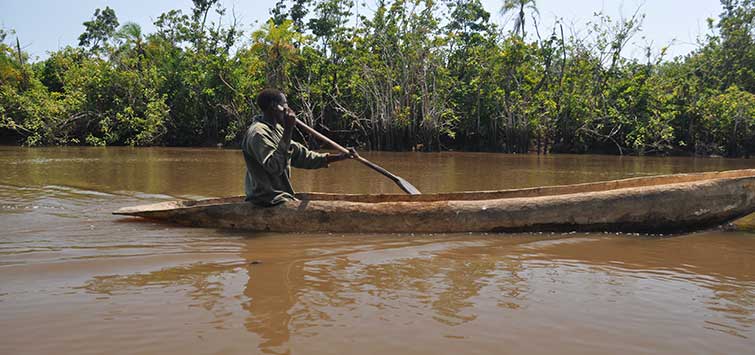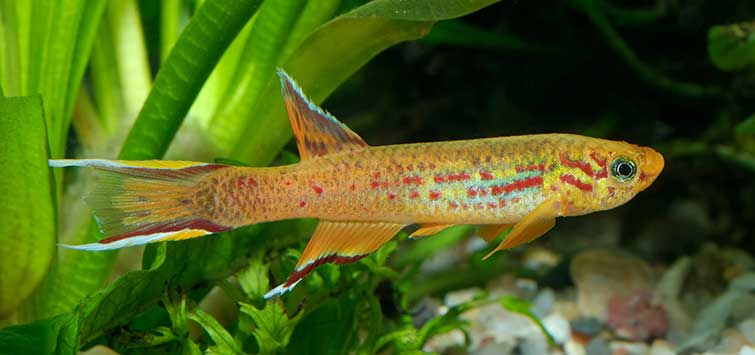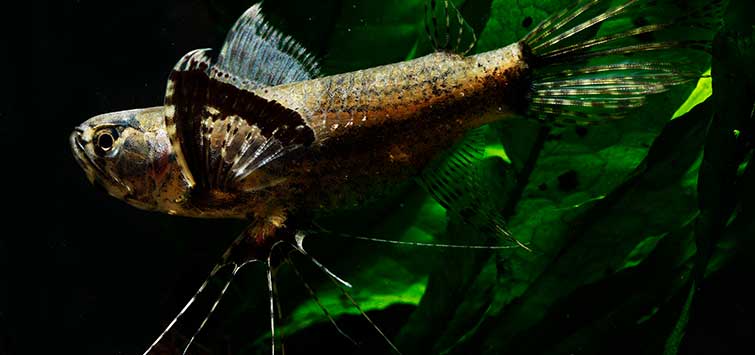Mozambican Marvels: Finding Freshwater Tropical Fish in Southeast Africa
Author: Lawrence Kent
A serial traveler with one eye always on the water returns to Africa, this time exploring the treasures of one of its largest and diverse countries. From a dolphin-like elephantfish to transparent glassfish that would make a perfect fit for home aquaria, Mozambique has it all for the aquatic enthusiast.
On to Mozambique
My job provided me the opportunity to visit Mozambique in February 2009. While the first five days of the trip were scheduled for meetings with crop breeders, nutritionists, and other government officials, I added a sixth day to look for freshwater fish, bringing along my seine and other nets for that purpose.
Arrival and Initial Collections
Mozambique is located on the southeast coast of Africa. It is a huge country, about 1600 miles from one end to the other. Most of my first day there was spent on a series of domestic flights from the capital in the south to the province of Zambezia in the north. I slept in a small hotel in the town of Quelimane that night and got up very early the next morning to check out the river scene for a couple of hours before my first meeting at 7:30 a.m. I walked there along Mao Tse Tung Avenue (Mozambique used to be a Marxist state—there’s even a Kim Il Sung Avenue in the capital), sweating in the high heat and humidity. The river flowing through town is called Bon Sinais, meaning “good signs” in Portuguese, the national language. I saw some local fishermen in small wooden canoes on the far bank about 400 yards away, and I convinced a couple of Mozambicans with a motorboat to take me over there for a look.
We pulled up to the traditional fishermen, who were busy with their nets, and I shouted to them in Spanish: “I want to see small fish and photograph them!” Portuguese speakers generally understand Spanish, as the two languages are closely related. The fishermen, most of whom were chest-deep in the water, laughed and showed me their nets teeming with piles of little squirming, sardine-like fish. I pointed to a couple of the more interesting-looking ones, which they handed me to inspect and photograph. The first was diamond-shaped, like a big mono or scat, and was as tall as it was long, with yellow fins. I didn’t recognize it. The next looked like a big gray goby, 8 inches long, with two dorsal fins adorned in blue speckles. Again, I didn’t recognize it. Wait a second, I thought—is this fresh water?
“NÃo, salgada!” the fishermen exclaimed. It was mostly salt water that had intruded into the river from the Indian Ocean a couple of miles away. This was not the right place for me, a freshwater guy. With some help from my friend Mike Hellweg, I later identified that mono-like fish as an adult natal moony Monodactylus argenteus, which can live in both salty and brackish water. We never succeeded in identifying the second fish, other than deciding that it must be some species of marine goby. A third fish found in that salty water was the African sea catfish Arius africanus, which can move from the ocean into brackish and even fresh water. It was a cool-looking fish, but not my cup of tea. I paid a few tips and headed back to my meeting.
Glassies, Cichlids, and More
My work was done five days later and I got my next chance. I visited the Umbeluzi River, a dozen or so miles southwest of the capital, Maputo. I hopped out of the car with Albeno, the driver, at a spot where the river was only about 50 feet wide and 5 feet deep. Some local boys came over to us, and I explained what we were after: small freshwater fish. One boy grabbed my dipnet and returned two minutes later with a dozen small, handsome, and transparent fish. Yes! This was a good spot. The fish were probably bald glassies Ambassis gymnocephalus, each only ½ inch long, with two distinct dorsal fins and an attractive, yellowish-green lateral line cutting across their see-through bodies. These glassies could be good residents for a community aquarium. They reportedly can live in both fresh and salt water. We put them into a small tank for photos and then went back to catch more among the rocks by the river’s edge.
Sardines and Tilapia
The boys then caught some river sardines Mesobola brevianalis, a slender, brown river goby Glossogobius callidus, and a few tilapia, some in the seine and some by hook and line. I find tilapia particularly hard to identify. These were olive green with red tails, red anal fins, and dusky dorsals sporting red margins and a black tilapia spot. By comparing my photos with those on the database at FishBase.org and limiting the search to fish found in Mozambique, I later deduced that these were probably Tilapia rendalli or T. sparrmanii—it was hard to tell.
I spotted some more of these cichlids from the riverbank, so I grabbed my castnet and went after them. Unfortunately I hadn’t used that net in over a year and—darn—forgot how to throw it properly! I couldn’t get it to spread open because I’d forgotten one of the steps in preparing the net for tossing, and I wound up looking pretty dumb. I had carried that heavy net in my suitcase 10,600 miles from Seattle, and now I couldn’t remember how to throw it! The locals rightly laughed at me, but I smiled because I was feeling pleased that we’d already caught some pretty good aquarium fish. In my hotel room that night, I looked up the castnet instructions on the Internet and wrote them down for any subsequent trip.
What Is It?
The boys caught an unfamiliar fish at the same part of the river. It was very high-backed, with a steep, sloping forehead, pointed snout, and a single dorsal fin on the posterior part of its back. It was 4 inches long, with sparkling blues and greens on its scales. What the heck was it? I searched my handy copy of the Baensch Aquarium Atlas (Mergus Verlag, 2002) but found no matches. “Wait a second, is this fresh water or more Água salgada?” I asked. Albeno said it was fresh water—we were over 20 miles from the ocean—but sometimes imigrantes come from the sea and up the river. That would explain it; the fish was probably a young picnic seabream Acanthopagrus berda that had voyaged from its normal home in the sea.
That same explanation was probably behind the next group of fish we caught at the little bridge about five miles farther south. There, Albeno convinced a couple of young men to use my 10-foot seine—one man holding each end—to round up some fish we could see from the bridge. Those little fish turned out to be baby mullet, each about 3 inches long, with pectoral fins set high on their sides like wings—similar to South American hatchetfish—leading one to conclude that they’re also surface dwellers. These sturdy, silvery fish were also imigrantes from the sea. They were maybe comoro mullet Agonostomus catalai, which grow up to 8 inches, fairy mullet A. telfairii, which can grow up to a foot and a half, or freshwater mullet Myxus capensis, which breed in the sea as adults but spend their younger days in rivers.
Scoring Tetras and Barbs
The men used the seine near the bridge again, and this time they came up with a net full of big, beautiful African tetras. Each was 3 to 4 inches long and silvery with large scales, with subtle, shimmery hues of green and blue along their upper flanks above the lateral line. Like many African tetras, the males had red tails and the females had yellow ones. They were probably slender robbers Rhabdalestes maunensis. Being quite delicate, several died quickly from the trauma of capture after just two minutes out of the water. I hoped to try to transport a few of these unusual tetras home to the states (I’ve never seen them for sale), but I gave up on the idea after witnessing their fragility.
I later shared photos of this tetra with Mike Hellweg, who said it looked like a slender or Okavango robber, but also noted that this species is only known from much farther inland. He suggested that it also could be a Rhabdalestes rhodesiensis, which is a similar tetra reported from the lower Zambezi River, although some texts claim that it is just a local variant of R. maunensis. Mike explained that he’s been unable to find any images other than line drawings of these fish, so it’s possible that mine are the first live photos. Who knows?
More Barbs
The next spot was a muddy, shallow pond farther south and just a few miles from the border with the Kingdom of Swaziland. Some enthusiastic locals helped us catch a lot of barbs here. The smaller ones were 2 inches long, each with a thin, black stripe dividing the body laterally, and the high dorsal fin that is characteristic of the genus, probably the east coast barb Barbus toppini. The second group looked similar, except for a slightly enlarged spot at the end of the lateral stripe and a black spot just above the anal fin, indicating that they were probably broadband barbs Barbus macrotaenia. The third set of barbs were bigger, about 3 inches, with red eyes, red-tinted and unpaired fins, and a dark lateral line tinged with blue on the upper margin dividing the coppery back from the white belly. These were the most attractive and most likely the Beira barb Barbus radiatus or a similar species, as many barbs look alike.
A Pair of Cichlids
We also found a pair of young Haplochromis-type cichlids in that pond. Mozambique borders on much of the eastern shore of Lake Malawi, which has a large abundance of haplochromine species, but we were over a thousand miles from that lake. These little yellowish cichlids were probably Astatotilapia calliptera, which can be found in many slow-moving waters in Eastern Africa.
Maternal Mouthbrooding
While at this shallow pond, Albeno and I spotted a school of about a hundred tiny black fish close to the shore. Albeno grabbed the dipnet, ready to pounce, but I told him to wait and watch. A mother cichlid, about 6 inches long, emerged from the shadows nearby, shook her head, and opened her mouth. All the tiny fish swam in, desperately trying to find a safe spot in their mother’s buccal cavity. I couldn’t identify the species, but she was definitely a maternal mouthbrooder, keen to protect her offspring from danger and inadvertently putting on a good show for Albeno and me—especially Albeno, who was amazed to see this behavior for the first time.
The Best for Last
I was scheduled to meet with the Minister of Science and Technology the next day and then fly home to Seattle. The meeting was canceled, however, freeing up my morning for a different activity. Albeno—bless his heart—agreed to a couple more hours of fish hunting before delivering me to the airport for my afternoon flight. This time we headed 30 miles north toward the town of Marracuene until we found a small, slow-moving stream by the roadside covered in lily pads and surrounded by small trees, tall grass, cassava, and banana plants. This was called the Rio Bonobo, and it looked perfect.
The first fish we caught were Aplocheilichthys killies. They were less than an inch in length, with a broad, black line separating their white bellies from their coppery-brown backs. These were most likely Aplocheilichthys katangae, the striped topminnow. Our activity by the stream caught the imagination of some locals, who gathered around to watch. One of them was boisterous and drunk, even though it was only 8:00 in the morning. His erratic behavior made me a bit nervous at first but we went with the flow, and Albeno convinced him and his friend George to jump into the stream with the seine.
After a couple of tries, the drunken man and his buddy came up with the main catch of the trip—a wonderful elephantfish. It looked like a small gray dolphin, with a protruding lower lip and elongated caudal peduncle—the appearance was quite loveable. The distinctive brown lobes on its forked tail helped us identify it as Marcusenius macrolepidotus, the large-scaled elephantnose or bulldog. I brought this terrific fish back to my hotel room and put it in a tank for further admiration and photos. Unfortunately, time was up and I had to depart from this impressive African locale brimming with countless, diverse species.
References
Baensch, H., and G. Fischer. 2002. Baensch Aquarium Atlas. Mergus Verlag. Germany. 1210 pp.
FishBase: www.fishbase.org
Mike Hellweg, personal communication.
Seegers, L. 2008. The Catfishes of Africa: A Handbook for Identification and Maintenance. Aqualog Verlag. Rodgau, Germany. 604 pp.
See the full article on TFH Digital http://www.tfhdigital.com/tfh/200912/#pg71

.png?h=595&iar=0&w=2781&hash=5FD5E69473BCC22199FBFA2FB71B6033)



